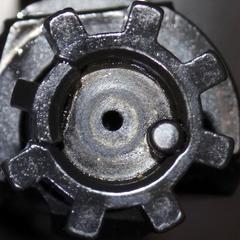-
Posts
1,057 -
Joined
-
Last visited
Reputation Activity
-
 Vellinious got a reaction from genexis_x in Pascal GPU Boost 3.0 topic, something every pascal owner should look at.
Vellinious got a reaction from genexis_x in Pascal GPU Boost 3.0 topic, something every pascal owner should look at.
I don't think the voltage/frequency curve works for Maxwell. It was new with boost 3.0 and Pascal.
-
.png) Vellinious reacted to KuronoXD in Firefox survey puts AMD GPU marketshare ahead of Nvidia.
Vellinious reacted to KuronoXD in Firefox survey puts AMD GPU marketshare ahead of Nvidia.
Easy there, no freedom of speech infringement. However, your ability of saying whatever you want does not equate to other people having to accept your sarcasm for a conclusion you came to on your own, about something you thought I meant.
tl;dr: I respect you can say whatever, but I don't have to accept your being a dick about it.
-
 Vellinious got a reaction from Carclis in I Need Help with Overclocking
Vellinious got a reaction from Carclis in I Need Help with Overclocking
What Carclis said.....and I'll add. Using the offset method, you're allowing the software to create a generic voltage / frequency curve, and they're usually pretty horrible. Setting the voltage / frequency curve manually, is key to a good overclock. As well as keeping the GPU as cold as possible. The colder it is, the higher you'll be able to get it to boost.
-
 Vellinious got a reaction from DildorTheDecent in I Need Help with Overclocking
Vellinious got a reaction from DildorTheDecent in I Need Help with Overclocking
What Carclis said.....and I'll add. Using the offset method, you're allowing the software to create a generic voltage / frequency curve, and they're usually pretty horrible. Setting the voltage / frequency curve manually, is key to a good overclock. As well as keeping the GPU as cold as possible. The colder it is, the higher you'll be able to get it to boost.
-
 Vellinious reacted to Carclis in I Need Help with Overclocking
Vellinious reacted to Carclis in I Need Help with Overclocking
If you've already found your limit in terms of +core clock then you can start altering the frequency curve. You can get to it by pressing ctrl+f. Assuming you don't have the extra voltage limit added your highest value on the curve should be 1062mv but if you maxed it then you should be up to 1093mv. Try playing around with those two points depending on if you turned the voltage to +100% or not and see how far you can push them.
-
 Vellinious got a reaction from JKsinsa in GPU Cooling QUestion
Vellinious got a reaction from JKsinsa in GPU Cooling QUestion
As the other poster said, I'd definitely reseat the GPU with a high quality thermal paste. Can't hurt, and will probably help.
Air flow in a case is important, obviously....slightly more intake, than exhaust, ensures positive air pressure inside the case, which should decrease dust build up.
Adding an AIO for the CPU....that's fine and good, but using the warm air from inside the case, to exhaust out through the radiator, will only decrease the AIO's cooling performance. Warmer air running through the radiator, increases the minimum temperature that the coolant can be cooled to, thus reducing efficiency. You ALWAYS want the coolest air possible, going through the radiator. There are no exceptions.
-
 Vellinious got a reaction from mikegray in Your Thoughts: Bykski Waterblock + Gigabyte GeForce GTX 1080 Ti Gaming OC
Vellinious got a reaction from mikegray in Your Thoughts: Bykski Waterblock + Gigabyte GeForce GTX 1080 Ti Gaming OC
I used a Bykski on a single 1080 FTW and EK blocks on two other 1080 FTWs I've had in an out of my rig. I kept the GPU with the Bykski block and sold the FTWs with the EK blocks. The Bykski cooled better than the EK blocks by about 12c under load, with clocks above 2200. I tried several different mounts, moved the blocks from one card to another, to see if it was something in the mount, or the GPU itself, but it didn't matter. The flow rates were slightly better and perform better by a decent margin every time.
Now, that's just this ONE block, but......I'm sold. I'll be using them again.
-
 Vellinious got a reaction from dragonhart6505 in 1070 silicon loterie?
Vellinious got a reaction from dragonhart6505 in 1070 silicon loterie?
Stop using offsets. Use the voltage / frequency curve.
When you set an offset overclock, you're allowing the software to create what roughly equates to a stock voltage / frequency curve by itself....it's essentially just raising every point across the curve up by your offset amount. As you can see below, I set an offset of +150 on the slider, but looking at the curve, it set +143. That's because 150 was outside of the 12mhz steps that Pascal uses. Disregard that for a second, and just look at the voltage. See how the curve that it's set, has a voltage for that clock at 1043mv? That's going to allow the GPU to try to run your prescribed clock at that voltage, before it bumps the voltage up. Micro-changes that like inherently cause instability.
Now we'll look at the voltage / frequency curve method. I've set an offset clock of +110, to get my voltage points close, then raised the frequency points for the voltages above 1043mv to higher clocks until I got to the voltage and frequency I was targeting. In this case, the exact same 2164 core clock (+143), except now, it's not going to try to run 1043mv, it's going to go straight to the 1081mv I've prescribed for it to run, and won't go any lower, unless it starts warming up, in which case, it would drop a step and run 2154 @ 1075mv. This GPU is under water, so the likelihood of that happening are slim and none, but.....on air, it could.
-
 Vellinious got a reaction from James09 in 1070 silicon loterie?
Vellinious got a reaction from James09 in 1070 silicon loterie?
Stop using offsets. Use the voltage / frequency curve.
When you set an offset overclock, you're allowing the software to create what roughly equates to a stock voltage / frequency curve by itself....it's essentially just raising every point across the curve up by your offset amount. As you can see below, I set an offset of +150 on the slider, but looking at the curve, it set +143. That's because 150 was outside of the 12mhz steps that Pascal uses. Disregard that for a second, and just look at the voltage. See how the curve that it's set, has a voltage for that clock at 1043mv? That's going to allow the GPU to try to run your prescribed clock at that voltage, before it bumps the voltage up. Micro-changes that like inherently cause instability.
Now we'll look at the voltage / frequency curve method. I've set an offset clock of +110, to get my voltage points close, then raised the frequency points for the voltages above 1043mv to higher clocks until I got to the voltage and frequency I was targeting. In this case, the exact same 2164 core clock (+143), except now, it's not going to try to run 1043mv, it's going to go straight to the 1081mv I've prescribed for it to run, and won't go any lower, unless it starts warming up, in which case, it would drop a step and run 2154 @ 1075mv. This GPU is under water, so the likelihood of that happening are slim and none, but.....on air, it could.
-

-

-
 Vellinious got a reaction from DjxJt13 in 1070 silicon loterie?
Vellinious got a reaction from DjxJt13 in 1070 silicon loterie?
Stop using offsets. Use the voltage / frequency curve.
When you set an offset overclock, you're allowing the software to create what roughly equates to a stock voltage / frequency curve by itself....it's essentially just raising every point across the curve up by your offset amount. As you can see below, I set an offset of +150 on the slider, but looking at the curve, it set +143. That's because 150 was outside of the 12mhz steps that Pascal uses. Disregard that for a second, and just look at the voltage. See how the curve that it's set, has a voltage for that clock at 1043mv? That's going to allow the GPU to try to run your prescribed clock at that voltage, before it bumps the voltage up. Micro-changes that like inherently cause instability.
Now we'll look at the voltage / frequency curve method. I've set an offset clock of +110, to get my voltage points close, then raised the frequency points for the voltages above 1043mv to higher clocks until I got to the voltage and frequency I was targeting. In this case, the exact same 2164 core clock (+143), except now, it's not going to try to run 1043mv, it's going to go straight to the 1081mv I've prescribed for it to run, and won't go any lower, unless it starts warming up, in which case, it would drop a step and run 2154 @ 1075mv. This GPU is under water, so the likelihood of that happening are slim and none, but.....on air, it could.
-
 Vellinious got a reaction from Lord Nicoll in 1070 silicon loterie?
Vellinious got a reaction from Lord Nicoll in 1070 silicon loterie?
Stop using offsets. Use the voltage / frequency curve.
When you set an offset overclock, you're allowing the software to create what roughly equates to a stock voltage / frequency curve by itself....it's essentially just raising every point across the curve up by your offset amount. As you can see below, I set an offset of +150 on the slider, but looking at the curve, it set +143. That's because 150 was outside of the 12mhz steps that Pascal uses. Disregard that for a second, and just look at the voltage. See how the curve that it's set, has a voltage for that clock at 1043mv? That's going to allow the GPU to try to run your prescribed clock at that voltage, before it bumps the voltage up. Micro-changes that like inherently cause instability.
Now we'll look at the voltage / frequency curve method. I've set an offset clock of +110, to get my voltage points close, then raised the frequency points for the voltages above 1043mv to higher clocks until I got to the voltage and frequency I was targeting. In this case, the exact same 2164 core clock (+143), except now, it's not going to try to run 1043mv, it's going to go straight to the 1081mv I've prescribed for it to run, and won't go any lower, unless it starts warming up, in which case, it would drop a step and run 2154 @ 1075mv. This GPU is under water, so the likelihood of that happening are slim and none, but.....on air, it could.
-
 Vellinious got a reaction from DildorTheDecent in what is the best benchmark
Vellinious got a reaction from DildorTheDecent in what is the best benchmark
Valley is actually horrible. It's more of a CPU benchmark anymore, than a GPU. Heaven is just "ok", but with high end hardware, you'll hit a bottleneck with it too.
Superposition, Firestrike, Timespy.....
-
.png) Vellinious reacted to HKZeroFive in What's the difference between FE and aftermarket FE?
Vellinious reacted to HKZeroFive in What's the difference between FE and aftermarket FE?
People calling reference cards "Founder's Edition" trigggers me more than it should.
But yes, the only difference is the brand that's selling them so the warranty/RMA process may differ. Otherwise, they're the exact same cards.
-
 Vellinious reacted to tikker in [SOLVED] X99 taichi dual monitor problem
Vellinious reacted to tikker in [SOLVED] X99 taichi dual monitor problem
You need to plug all displays into a single card.
-
 Vellinious reacted to done12many2 in LTT 3DMark Thread
Vellinious reacted to done12many2 in LTT 3DMark Thread
That's the new LTT way for you. Most people doing so don't actually know what they are hyping or have any intention of owning. They just do it solely for hyping AMD because Linus has been buttering up to AMD lately.
It's like half the protestors in the US. Walk up and ask them what they are protesting and they don't have a clue. It was popular so they joined in.
-
 Vellinious got a reaction from PCGuy_5960 in LTT 3DMark Thread
Vellinious got a reaction from PCGuy_5960 in LTT 3DMark Thread
The thing I worry about, is TIM between the die and IHS. I'm not all that thrilled with the thought of buying a $2k processor, and have the need to delid (voiding the warranty) in order to get decent temps. I sure hope Intel doesn't make that mistake.....but they probably will. Here's to hoping they don't go full retard.....
-
 Vellinious reacted to Jumper118 in LTT 3DMark Thread
Vellinious reacted to Jumper118 in LTT 3DMark Thread
its because 3dmak doesnt use the whole cpu. i think the software doesnt know what to do with it the 6950x has really bad issues in the combined test when pair with 2 amd cards in cf as well. its just one of those things that needs an update to fix
and also that isnt a usual none backed up answer because i asked 8pack about the low scores in his threadripper bundles thread and he Illuuminati confirmed it
-
 Vellinious reacted to done12many2 in LTT 3DMark Thread
Vellinious reacted to done12many2 in LTT 3DMark Thread
Very true. I think we'll be in for a surprise with the 12c-18c parts. Die surface area should be increasing. So the 12c part will more than likely cool much better than the 7900x. We'll have to wait and see, but something tells me that I'm going to be glad that I didn't hang on to the 10c.
-
 Vellinious got a reaction from done12many2 in Unigine Valley Benchmark Scores Thread + SUPERPOSITION ***Over 1000 Submissions!***
Vellinious got a reaction from done12many2 in Unigine Valley Benchmark Scores Thread + SUPERPOSITION ***Over 1000 Submissions!***
Why do people even bother running Valley anymore? At this point, it's a really pretty CPU benchmark.
-
 Vellinious reacted to done12many2 in Unigine Valley Benchmark Scores Thread + SUPERPOSITION ***Over 1000 Submissions!***
Vellinious reacted to done12many2 in Unigine Valley Benchmark Scores Thread + SUPERPOSITION ***Over 1000 Submissions!***
Because it's easy. It is pretty garbage for determining GPU power on modern GPUs.
-
 Vellinious got a reaction from done12many2 in gtx 1080ti 2750mhz
Vellinious got a reaction from done12many2 in gtx 1080ti 2750mhz
Buying a KPE and leaving it on air, or even water, and hoping for a better overclock than any other 1080ti can offer, is straight stupid. I simply can't explain it any easier than that.
-
 Vellinious got a reaction from knightslugger in gtx 1080ti 2750mhz
Vellinious got a reaction from knightslugger in gtx 1080ti 2750mhz
50 is ok....30 would be better. 20c can make the different between a clock needing 1.093v to run, and only need 1.081v or lower to run it. The colder it is, the higher you'll get it to overclock, and the less voltage you'll need to hit your target.
An example. This card will barely hit 2214 with the load temps at 35c with ambient temps at 18-19c. But, lower the ambient temps so it's peak temp is 20c lower, and it hits 2278. 2252 runs a lot better, though, because 2278 is pushing high enough that it doesn't run very well. In fact, the frame rates in the benchmarks were quite a bit higher at 2252, than they were at 2278. Because, as I've said....the colder they are, the higher they'll clock, and the better they'll run when they get there.
Winter is just around the corner.....
-
 Vellinious reacted to DildorTheDecent in Can someone with a GTX 970 run a benchmark for me
Vellinious reacted to DildorTheDecent in Can someone with a GTX 970 run a benchmark for me
Pascal doesn't really have binning. If it was "heavily binned" then it would be doing 2150+ ez. Only binned card i can think of is the GTX 1080 Ti KPE. All of them are guaranteed a 2025MHz+ OC. Most Pascal cards are going to wind up around 2000MHz.
You know it kid. Those are hardly compression artifacts now are they?










